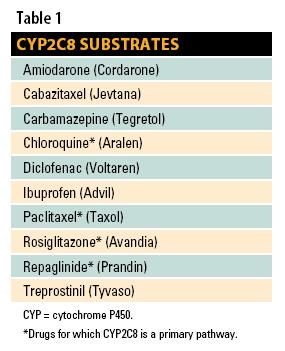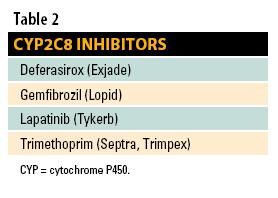Publication
Article
Pharmacy Times
Get to Know an Enzyme: CYP2C8
Pharmacists should be familiar with drugs that impact the activity of the enzyme cytochrome P450 2C8.
Pharmacists should be familiar with drugs that impact the activity of the enzyme cytochrome P450 2C8.

associated with the metabolism of a number of common therapeutic agents.
The enzyme CYP2C8 constitutes about 7% of the cytochrome content in the liver.1 Additionally, CYP2C8 protein has been detected in the intestine, kidneys, and brain. CYP2C8 is known to convert arachidonic acid in the kidneys to active metabolites that influence sodium transport, water reabsorption, and vascular tone.
Genetic Influences
Racial background is an important factor in the likelihood of being deficient in CYP2C8. The common variants are CYP2C8*2 and CYP2C8*3, both having reduced activity compared with the normal form. About 15% of black patients have the CYP2C8*2 variant; however, this variant is very rare (<1%) in white patients. The CYP2C8*3 variant is found in about 20% of whites, but is rare in blacks. Patients who are homozygous (CYP2C8*2/*2 or CYP2C8*3/*3) have lower intrinsic clearance of CYP2C8 substrates than those who are heterozygous (CYP2C8*1/*2 or CYP2C8*1/*3).
CYP2C8 Substrates
Some of the drugs identified as substrates for CYP2C8 are listed in Table 12. Many drugs are metabolized by more than 1 CYP enzyme, and this is especially true for CYP2C8, where it is often a secondary pathway. Nonetheless, there are some drugs for which CYP2C8 is known to be an important pathway, and these are listed with an asterisk (*) in Table 1.
CYP2C8 Inhibitors
Drugs that inhibit CYP2C8 activity (Table 2) are likely to increase the plasma concentrations of the medications listed with an asterisk in Table 1, and in some cases adverse outcomes may occur. For the other drugs in Table 1, for which other enzymes may be more important, the outcome of the interaction is more difficult to predict.
CYP2C8 Inducers
The only drug that has been shown to induce (stimulate) CYP2C8 in vivo is rifampin. Rifampin is known to induce several drug metabolism pathways, so it is likely to reduce the plasma concentration of CYP2C8 substrates even if they have multiple pathways of elimination. Enzyme inducers tend to be “broad spectrum,” in that they often induce several CYP isozymes, so it is possible that other inducers (eg, phenobarbital, St. John’s wort) may also induce CYP2C8.

Perhaps the most important drug interaction involving CYP2C8 was the interaction between cerivastatin and gemfibrozil. Cerivastatin was the only statin primarily metabolized by CYP2C8. When gemfibrozil (an inhibitor of both CYP2C8 and organic anion-transporting polypeptide-mediated elimination of cerivastatin) was administered in combination with cerivastatin, the risk of developing rhabdomyolysis increased greatly. As a result, cerivastatin was removed from the market.
Because drugs metabolized by CYP2C8 often have other pathways, if the patient is genetically deficient in one of the other pathways or is administered an inhibitor of an alternative pathway, inhibition of CYP2C8 may become more important. Repaglinide is metabolized by both CYP2C8 and CYP3A4. When subjects receiving repaglinide were concurrently administered itraconazole (inhibition of CYP3A4) or gemfibrozil, the area under the concentration time curve (AUC) of repaglinide increased by 40% and 8-fold, respectively, compared with repaglinide alone. When itraconazole and gemfibrozil were coadministered, the AUC of repaglinide increased about 20-fold. 3
Summary
The cytochrome P450 enzyme CYP2C8 is at least partly involved in the metabolism of a number of drugs, but inhibitors of CYP2C8 will tend to have the greatest effect on drugs for which CYP2C8 is the primary pathway. But CYP2C8 inhibition by itself may not cause toxicity because for many of the drugs that are substrates of CYP2C8, the alternative pathways often take over. Nonetheless, inhibition or induction of CYP2C8 sometimes results in adverse drug interactions, so it should not be ignored. PT
Drs. Horn and Hansten are both professors of pharmacy at the University of Washington School of Pharmacy. For an electronic version of this article, including references if any, visit www.hanstenandhorn.com.
References
1. Rendic S, Di Carlo FJ. Human cytochrome P450 enzymes: a status report summarizing their reactions, substrates, inducers and inhibitors. Drug Metab Rev. 1997;29:413-580.
2. Totah RA, Rettie AE. Cytochrome P450 2C8: substrates, inhibitors, pharmacogenetics, and clinical relevance. Clin Pharmacol Ther. 2005;77:341-352.
3. Niemi M, Backman JT, Neuvonen M, Neuvonen PJ. Effects of gemfibrozil, itraconazole, and their combination on the pharmacokinetics and pharmacodynamics of repaglinide: potentially hazardous interaction between gemfibrozil and repaglinide. Diabetologia. 2003;46:347-351.







